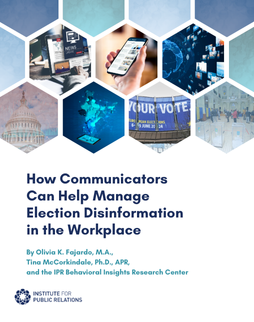Does academic research matter to public relations practitioners? Be not afraid. Come into the light with me, a non-PhD practitioner who finds value in academic research. In this series of posts, I will seek out quality academic and other research, drawing insights for communications practitioners.
Communicating in an environment of risk is one of the more difficult roles for senior communications strategists.
In larger organizations risk assessment often is managed by Enterprise Risk Management (ERM), which sets the risk agenda based on its discipline-specific quantitative tools and processes. But communicators may find that ERM tools rarely predict reputation risk and often fail to provide a framework for effective mitigation through communications.
An ERM expert may compare the death rates from nuclear power to those from smoking and conclude nuclear power presents low risk to the enterprise. People who live near a nuclear plant may feel dread [or the inability to control an event that may result in catastrophe] that is significantly out of proportion to the fatality rates. Facts do not trump emotion, as communicators know instinctively.
Into this chasm of confusion step researchers who focus on risk communication, a field that has applicability to communicators by examining how people hear messages in certain situations, and the implications for the choices they make. Among other benefits it provides a fact base for the use of emotion.
Professor John Maule is one such researcher. He directs the Centre for Decision Research at Leeds University Business School. He and colleagues analyze perception and the efficacy of methods of communication in risk situations, seeking answers to questions that are essential for strategic communications.
In a recent article Maule cites research that identifies five key attributes for effective risk communication: competence, objectivity, fairness, consistency and acting in good faith. He cites research that suggests communicators should understand how each stakeholder group looks at risk, and at the world. This may require research in the form of traditional focus groups and surveys, or through metadata from social intelligence that unpacks the public dialogue and what it means for a company, product or issue.
He points to a body of work that questions whether we should frame a risk qualitatively or quantitatively for better effect. For example, researchers suggest that we value human life proportionally. The higher the percentage of a group that might be impacted by a risk the more concern we are likely to feel. So, we might feel greater concern when 5,000 people out of 25,000 are affected by a disaster than 5,000 out of one million.
Maule presents a wide-ranging body of research (with a valuable bibliography with which to dive deeper) with some key findings for communicators.
— Approach risk communication as a two-way dialogue between your experts and the public that results in a common understanding of the risks.
–Understand that past experience has a strong influence on whether people will assign the same level of risk you do to a situation. (As a young Kansan I experienced many tornado warnings that did not impact me. But ignoring such warnings could have proved fatal had I been in Joplin, Missouri last spring.)
— Risks that are hard to visualize may not be as compelling. Maule discusses examples of organizations over-predicting risks such from hackers and under-predicting risks from system overloads, when the latter may be a far more common experience.
— Risk communicators should understand and monitor psychological issues such as dread and lack of familiarity attached to their issues, products and programs so they can better predict and communicate risks to the general public.
He divides risk into four types or sources of threats: to well-being, infrastructure, customers and to the public. Have you done communications scenario planning around each type of risk? Are you using social intelligence to track the likelihood and velocity of these types of threats? Do you understand the psychological issues associated with each major risk issue facing your organization?
There are tools that help the communicator understand the emotions inherent in issues in the public dialogue and identify messaging that addresses the concerns. Communications that ignore the emotional underpinnings of an issue may be viewed as cold, uncaring and irrelevant.
On the other hand, communicators who actively monitor and listen, and who engage with the ERM team to bring an outside-in perspective, are more likely to manage risk appropriately, thus protecting the reputation of their organization.
Articles used for this post: “Risk Communication in Organizations,” a chapter by AJ Maule in the forthcoming forthcoming paperback edition of “The Oxford Handbook of Organizational Decision Making” by Gerard P. Hodgkinson and William H. Starbuck, Oxford University Press, 2008; and “Translating Risk Management Knowledge: The Lessons to be Learned from Research on the Perception and Communication of Risk” by AJ Maule, in Risk Management: An International Journal 2004, 6 (2) 17 – 29.
Linda Locke, principal at Reputare Consulting, subscribes to journals from which she draws inspiration and concepts for clients of her corporate reputation consulting practice. If you wish to suggest a research article for her review, contact her at Linda.Locke@ReputareConsulting.com, or DM her on Twitter @Reputationista.



